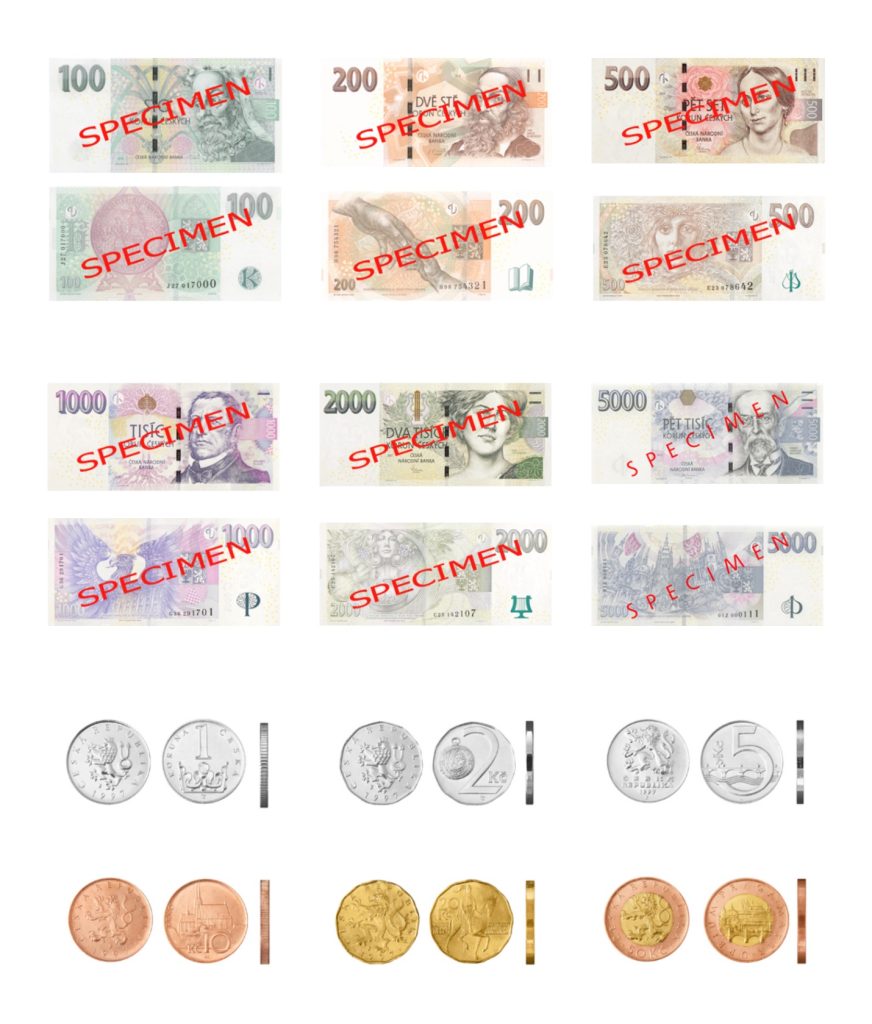If you’re visiting Prague for the first time, Czech coins and banknotes might seem unfamiliar. Don’t worry – we’ll take a closer look so you’ll know exactly what to expect in your wallet during your stay. The Czech Republic uses 6 different coins and 6 denominations of banknotes, each with fascinating stories and historical significance that reflect our country’s rich heritage.
Czech Coins
Coins are straightforward and easy to recognize, making them perfect for small purchases. They include values of 1, 2, 5, 10, 20, and 50 Czech crowns. You’ll find them handy for public transport tickets, snacks, tipping or tossing into fountains.
Czech Banknotes
Banknotes, on the other hand, are a bit more complex. Not only do they have higher values, but they’re also equipped with advanced security features to help you identify genuine Czech crowns and feel confident when paying. Plus, they showcase historical figures and symbols, offering a glimpse into the nation’s cultural and political legacy.

Here’s a quick guide to Czech banknotes:
- 100 CZK: A green banknote featuring Charles IV, the Czech king and Holy Roman Emperor, on the front, with themes related to his reign on the reverse.
- 200 CZK: An orange banknote depicting John Amos Comenius, the “Father of Modern Education”, with motifs tied to his teaching on the reverse side.
- 500 CZK: A purple banknote with Božena Němcová, a famous writer, on the front, and scenes from her literary works on the reverse.
- 1,000 CZK: A purple banknote showing historian and politician František Palacký, with imagery linked to his contributions to Czech history.
- 2,000 CZK: A green-blue banknote featuring opera singer Ema Destinnová on the front, adorned with musical themes on the reverse.
- 5,000 CZK: A gray-blue note with Tomáš Garrigue Masaryk, the founding father of Czechoslovakia and our first president, on the front, and symbols of the country’s founding on the reverse.
The 5000 Banknote
You’re unlikely to encounter the 5,000 CZK note during your visit. Even we rarely see it! Most ATMs in the Czech Republic dispense notes up to 2,000 CZK, making the 5,000 CZK note something of a rarity. If you do come across one, be aware that some shops might hesitate to accept it, citing concerns about counterfeiting or insufficient change. Legally, however, all retailers are required to accept it, though real-life experiences may vary.
How to Spot Genuine Czech Crowns
Each banknote comes with a range of security features to help you distinguish real notes from counterfeit ones. These include watermarks, holographic strips, and UV-sensitive elements that reveal hidden patterns under ultraviolet light.
- 100 CZK: Protective elements; banknote under UV light
- 200 CZK: Protective elements; banknote under UV light
- 500 CZK: Protective elements; banknote under UV light
- 1,000 CZK: Protective elements; banknote under UV light
- 2,000 CZK: Protective elements; banknote under UV light
- 5,000 CZK: Protective elements; banknote under UV light
While encountering counterfeit currency in the Czech Republic is uncommon, it’s wise to remain vigilant. In 2023, approximately 2,100 counterfeit banknotes were detected. By 2024, this number significantly decreased to around 800. Although the likelihood of receiving a fake banknote is low, it’s prudent to familiarize yourself with the security features of Czech currency to ensure a smooth experience during your visit.